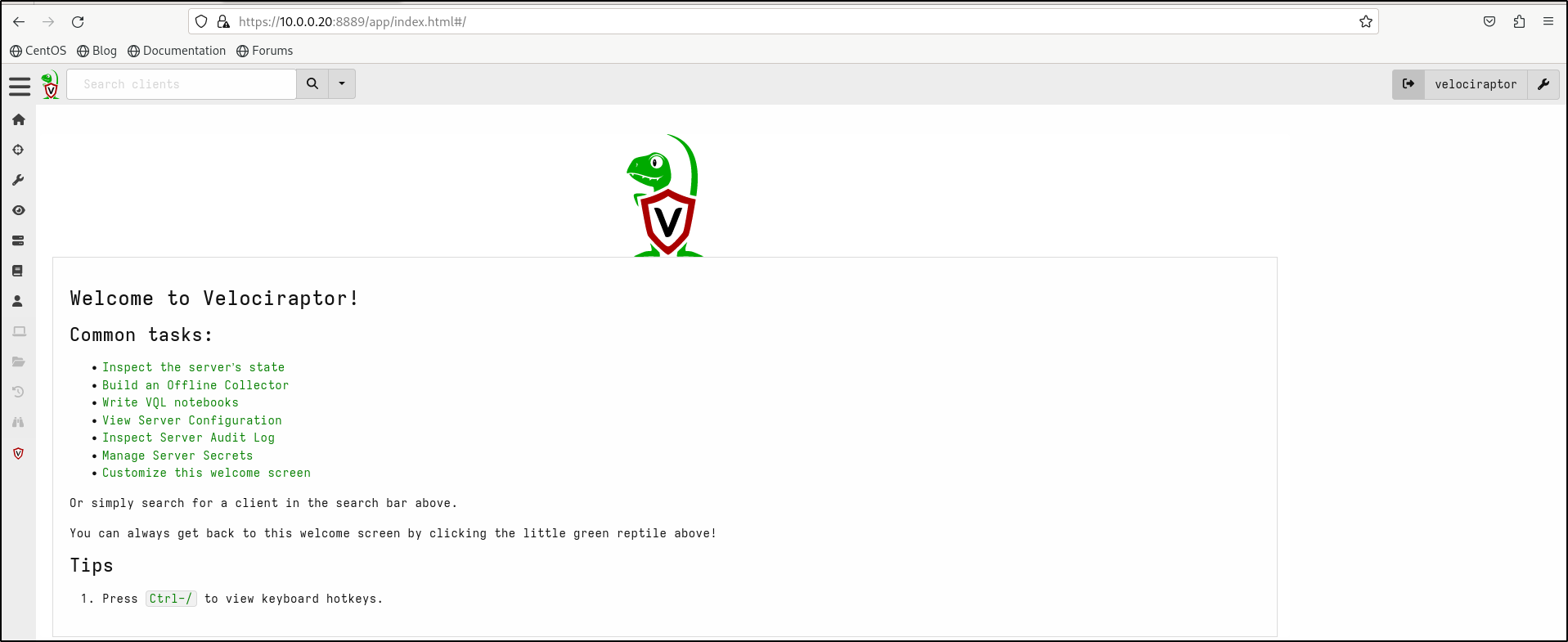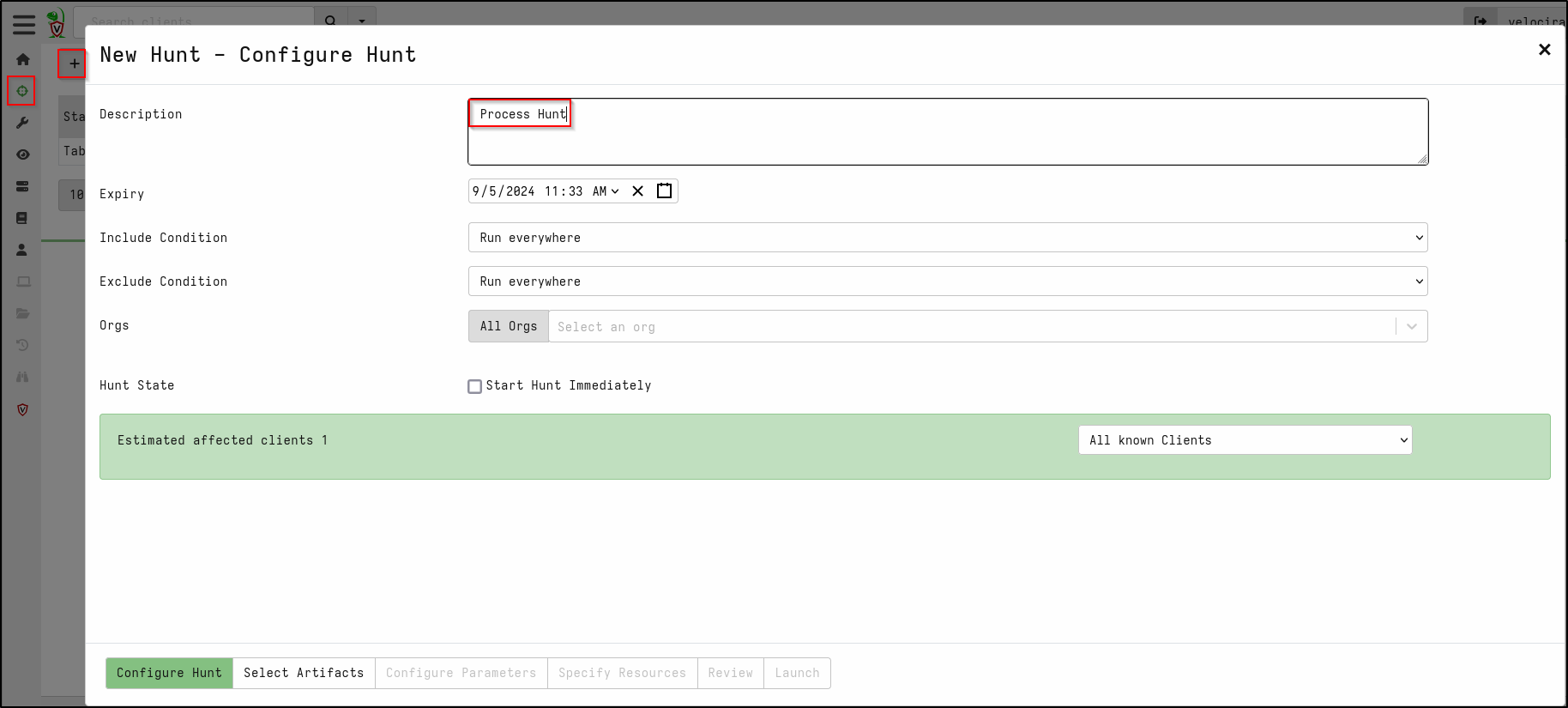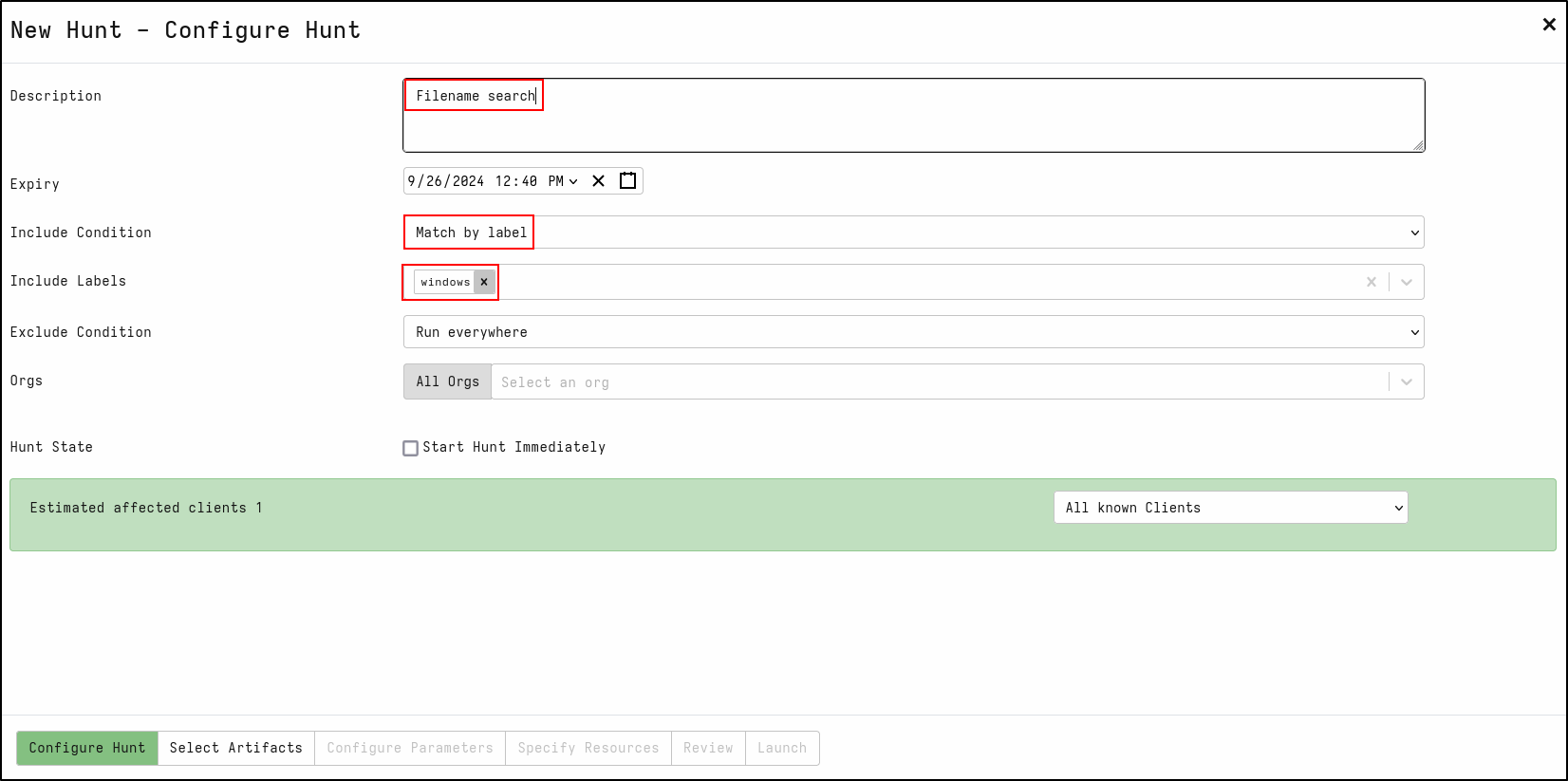Velociraptor
Velociraptor is an advanced digital forensic and incident response tool that enhances your visibility into your endpoints.
Lab Setup for Proof of Concept
In this proof of concept, the Velociraptor server was configured on an Ubuntu virtual machine (VM), and the Velociraptor client was configured on a Windows VM. An attack simulation was conducted on the Windows hosts using a Kali machine in a safe and controlled setting.
Note: Do not attempt to replicate the attack emulation demonstrated here unless you are properly trained and it is safe to do so. Unauthorised attack emulation can lead to legal consequences and unintended damage to systems. Always ensure that such activities are conducted by qualified professionals in a secure, isolated environment.
| Host | OS | Role | IP Address |
|---|---|---|---|
| Fortigate | Fortios 7.6.0 | Firewall/Router | 192.168.1.111 (WAN) / 10.0.0.1 (LAN) |
| WazuhServer | Ubuntu 22.04 LTS | Velociraptor Server | 10.0.0.20 |
| WS2019 | Windows Server 2019 | Velociraptor Client | 10.0.0.40 |
| Kali | Kali Linux 2024.2 | Attacker machine | 10.0.0.22 |
Deploy Velociraptor Server using Self-Signed SSL
Self-Signed SSL
Velociraptor deployments are secured using a self-signed Certificate Authority (CA) that is generated during the initial configuration generation step. The client’s configuration contains the signed CA, which is used to verify all certificates needed during communications.
In self-signed SSL mode, Velociraptor issues its own server certificate using its internal CA. This means the Admin GUI and front end also use a self-signed server certificate.
When to use this method
This type of deployment is most appropriate for on-premises scenarios where internet access is not available or egress is blocked.
Self-Signed Certificates
Self-signed SSL certificates trigger SSL warnings in all web browsers. When accessing the Admin GUI you will receive a certificate warning about the possibility of a MITM attack.
As a precaution, Velociraptor only exports the GUI port on the loopback interface. You may change the GUI.bind_address setting to “0.0.0.0” to receive external connections on this port, but this is not recommended. Instead, you should use SSH tunneling to connect to the local loopback interface.
Velociraptor doesn’t support other self-signed SSL certificates, and we don’t recommend attempting to create and upload your own internal self-signed certificate to Velociraptor.
Generate config files for the server and client
Download the latest Velociraptor binary that is compatible for your host architecture from https://github.com/Velocidex/velociraptor/releases.
Change the permission of the Velociraptor binary.
Make the directory /opt/velociraptor
Generate a new config file by running velociraptor in interactive mode
Select linux for OS
Set Path to the datastore directory as default /opt/velociraptor (hit enter)
Select Self Signed SSL
For the public DNS name of the Master Frontend, enter your IP address (e.g. 10.0.0.20)
For the frontend port, select default port of 8000 (hit enter)
Note: If you are installing Velociraptor server on same machine as where the Splunk Enterprise is installed, set your frontend port to something else (e.g. 7000) to avoid conflict.
For the GUI port, select default port of 8889 (hit enter)
For WebSocket, answer N (hit enter)
For the registry to store the writeback files, answer N (hit enter)
For DynDns provider, answer none (hit enter)
Create GUI username and password
When prompted to create GUI username again, hit enter to end
Set Path to the logs directory as default /opt/velociraptor/logs (hit enter)
For restricting VQL functionality on the server, answer N (hit enter)
For where should I write the server config file, hit enter to set it to server.config.yaml
For where should I write the client config file, hit enter to set it to client.config.yaml
Note the question is actually asking for file name instead of file path.
#Example output
Welcome to the Velociraptor configuration generator
---------------------------------------------------
I will be creating a new deployment configuration for you. I will
begin by identifying what type of deployment you need.
What OS will the server be deployed on?
linux
? Path to the datastore directory. /opt/velociraptor
? Self Signed SSL
? What is the public DNS name of the Master Frontend (e.g. www.example.com): 10.0.0.20
? Enter the frontend port to listen on. 8000
? Enter the port for the GUI to listen on. 8889
? Would you like to try the new experimental websocket comms?
Websocket is a bidirectional low latency communication protocol supported by
most modern proxies and load balancers. This method is more efficient and
portable than plain HTTP. Be sure to test this in your environment.
No
? Would you like to use the registry to store the writeback files? (Experimental) No
? Which DynDns provider do you use? none
? GUI Username or email address to authorize (empty to end): cyber
? GUI Username or email address to authorize (empty to end):
[INFO] 2024-09-18T20:53:27Z _ __ __ _ __
[INFO] 2024-09-18T20:53:27Z | | / /__ / /___ _____(_)________ _____ / /_____ _____
[INFO] 2024-09-18T20:53:27Z | | / / _ \/ / __ \/ ___/ / ___/ __ `/ __ \/ __/ __ \/ ___/
[INFO] 2024-09-18T20:53:27Z | |/ / __/ / /_/ / /__/ / / / /_/ / /_/ / /_/ /_/ / /
[INFO] 2024-09-18T20:53:27Z |___/\___/_/\____/\___/_/_/ \__,_/ .___/\__/\____/_/
[INFO] 2024-09-18T20:53:27Z /_/
[INFO] 2024-09-18T20:53:27Z Digging deeper! https://www.velocidex.com
[INFO] 2024-09-18T20:53:27Z This is Velociraptor 0.72.0 built on 2024-04-25T16:09:17Z (7e4da7a)
[INFO] 2024-09-18T20:53:27Z Generating keys please wait....
? Path to the logs directory. /opt/velociraptor/logs
? Do you want to restrict VQL functionality on the server?
This is useful for a shared server where users are not fully trusted.
It removes potentially dangerous plugins like execve(), filesystem access etc.
NOTE: This is an experimental feature only useful in limited situations. If you
do not know you need it select N here!
No
? Where should I write the server config file? server.config.yaml
? Where should I write the client config file? client.config.yaml
Verify that both server and client config files are generated in the present working directory
Copy the config files to /opt/velociraptor directory
Edit server.config.yaml in the /opt/velociraptor directory
Verify that Client: server_urls: is set to https://<IP address>:8000/
Edit GUI: bind address: to point to your Velociraptor server IP address
Create the Velociraptor server package for deb that included the generated configuration file:
sudo ./velociraptor-v0.72.0-linux-amd64 --config /opt/velociraptor/server.config.yaml debian server --binary velociraptor-v0.72.0-linux-amd64
Install the server package
This process creates a new user, system user and group called velociraptor
A service is created to automatically start Velociraptor anytime the server is restarted
Verify the /opt/velociraptor is accessible by user and group velociraptor
total 24
drwxr-xr-x. 9 velociraptor velociraptor 175 Aug 28 09:03 .
drwxr-xr-x. 5 root root 52 Aug 28 07:09 ..
drwx------. 2 velociraptor velociraptor 68 Aug 28 09:03 acl
-rw-------. 1 velociraptor velociraptor 2725 Aug 28 07:19 client.config.yaml
drwx------. 3 velociraptor velociraptor 20 Aug 28 09:03 clients
drwxr-xr-x. 3 velociraptor velociraptor 168 Aug 28 09:03 config
drwx------. 2 velociraptor velociraptor 4096 Aug 28 09:03 logs
drwx------. 3 velociraptor velociraptor 35 Aug 28 09:03 server_artifact_logs
drwx------. 5 velociraptor velociraptor 104 Aug 28 09:03 server_artifacts
-rw-------. 1 velociraptor velociraptor 13172 Aug 28 08:54 server.config.yaml
drwx------. 2 velociraptor velociraptor 29 Aug 28 09:03 users
---
total 36
drwxr-xr-x 9 velociraptor velociraptor 4096 Sep 19 09:06 .
drwxr-xr-x 5 root root 4096 Sep 19 08:13 ..
drwx------ 2 velociraptor velociraptor 4096 Sep 19 09:06 acl
drwx------ 3 velociraptor velociraptor 4096 Sep 19 09:06 clients
drwxr-xr-x 3 velociraptor velociraptor 4096 Sep 19 09:06 config
drwx------ 2 velociraptor velociraptor 4096 Sep 19 09:06 logs
drwx------ 3 velociraptor velociraptor 4096 Sep 19 09:06 server_artifact_logs
drwx------ 5 velociraptor velociraptor 4096 Sep 19 09:06 server_artifacts
drwx------ 2 velociraptor velociraptor 4096 Sep 19 09:06 users
Verify velocirpator_server.service is active and running
Access the Velociraptor by typing https://<IP address>:8889
Sign in with the user you created
Configure Firewall
On CentOS host, run the following command
#Show original state
firewall-cmd --list-all
#Velociraptor ports
firewall-cmd --zone=public --add-port=8000/tcp --permanent # Frontend
firewall-cmd --zone=public --add-port=8889/tcp --permanent # Web GUI
firewall-cmd --reload
#Check applied
firewall-cmd --list-all
On Ubuntu, run the following command:
sudo ufw allow 8000/tcp # syslog TCP
sudo ufw allow 8889/udp # syslog UDP
#Apply changes
sudo ufw reload
#Enable Firewall
#sudo ufw enable
#Apply changes
sudo ufw status numbered
Configure Velociraptor Client (Windows)
Option 1: Official release MSI
The recommended way to install Velociraptor as a client on Windows is via the release MSI on the Github releases page. Download the Velociraptor MSI (velociraptor-v0.72.0-windows-amd64.msi) . On your Windows host, double-click the msi or run the following command on Command Prompt:
msiexec /i [velociraptor-v0.72.0-windows-amd64.msi](https://github.com/Velocidex/velociraptor/releases/download/v0.72/velociraptor-v0.72.0-windows-amd64.msi)
Navigate to C:\Program Files\Velociraptor and delete the existing client.config.yaml
Transfer client.config.yaml from Linux host to Windows client using your preferred method.
From the Linux host in the /opt/velociraptor folder, host a HTTP server by running:
From Windows client, open PowerShell as Administrator. Change directory into C:\Program Files\Velociraptor and run:
You will see velociraptor.writeback.yaml appear. If the writeback YAML file does not appear, restart the computer.
Option 2: Configure MSI package via Velociraptor Server
Since the Velociraptor client requires a unique configuration file to identify the location of the server, we can’t package the configuration file in the official release. Therefore, the official MSI does not include a valid configuration file. You will need to modify the MSI to pack your configuration file (that was generated earlier) into it.
Navigate to Velociraptor web GUI. Click on the server icon. Add new collection by clicking + button.
Search for Server.Utils.CreateMSI and click launch. The produced MSI will be available in the Uploaded Files tab.
Click on the filename to download the MSI
Rename the file as velociraptor-v0.72.0-windows-amd64.msi
Transfer the file to your Windows client using your preferred method.
From the Linux host in the downloads folder, host a HTTP server by running:
From Windows client, open PowerShell as Administrator and run:
iwr -uri http://10.0.0.20:9999/velociraptor-v0.72.0-windows-amd64.msi -Outfile velociraptor-v0.72.0-windows-amd64.msi
If required, create a new rule in Firewall to temporarily allow access on port 9999. Remember to delete the rule after the file transfer.
On your Windows client, double-click the msi or run the following command on Command Prompt:
msiexec /i [velociraptor-v0.72.0-windows-amd64.msi](https://github.com/Velocidex/velociraptor/releases/download/v0.72/velociraptor-v0.72.0-windows-amd64.msi)
Verify client connection
On the Velociraptor Server web GUI, click on the magnifying glass icon and verify that your client is connected.
Any client that has successfully enrolled will show a green light
Introduction to Velociraptor
Creating a Process Hunt
A Windows reverse shell named 1.exe was generated and executed on the Windows Server 2019 host, connecting to the Kali machine. The session was then switched from Command Prompt to PowerShell.
[*] Started reverse TCP handler on 10.0.0.22:4444
[*] Command shell session 1 opened (10.0.0.22:4444 -> 10.0.0.40:49886) at 2024-09-18 19:56:51 -0400
Shell Banner:
Microsoft Windows [Version 10.0.17763.3650]
-----
C:\Users\Administrator\Downloads>whoami
whoami
ws2019\administrator
C:\Users\Administrator\Downloads>powershell
powershell
Windows PowerShell
Copyright (C) Microsoft Corporation. All rights reserved.
Create New Hunt by clicking Hunt icon and + icon
In the Configure Hunt tab, add the description Process Hunt
In the Select Artifacts tab, search for pstree. Select Generic.System.Pstree
This artifact displays the call chain for every process on the system by traversing the process’s parent ID.
In the same tab, search for pslist and select Windows.System.Pslist
This artifact list processes and their running binaries
In the Configure Parameters tab, Edit Generic.system.Pstree
Select IncludePstree
Select Review then Launch. Select the Hunt and click Play button to launch it.
Once the Hunt is complete (indicated by Total schedules and Finished clients), click the stop button to stop the Hunt.
Check the results on the Notebook tab on web GUI.
As shown in the screenshot below, the suspicious activity is detected.
Alternatively, if you prefer to Download Results as a CSV file and view it in an Excel, this can be done in the Results Section > Download Results
Adding Client Labels
To create a label, click the magnifying glass icon, select the target host, then click the label icon. Name the new label (e.g., windows).
Verify that the label has been created.
Creating a Filename Search Hunt
A malicious PowerShell script called justascript.ps1 was created then removed on Windows client.
Create a new hunt with the description Filename search
For Include Condition, select Match by label
For Include Labels, select windows
On the Select Artifacts tab, type filename and select Windows.Forensics.FilenameSearch
On the Configure Parameters tab, click spanner icon to configure.
In the yaraRule, replace my secret fie.txt with justascript.ps1
Select Review then Launch. Run hunt by clicking the play icon. Once the hunt is finished, stop the hunt by clicking the stop icon. View results in the Notebook tab. Velociraptor detects that the script is in the Recycle bin.
Creating a Hash Hunt
Mimikatz is a tool used to find and steal passwords from Windows computers. The mimikatz.exe was copied over to Windows client and have been renamed as justanexe.exe.
Create a new hunt with the description Hash Hunt
For Include Condition, select Match by label
For Include Labels, select windows
On the Select Artifacts tab, type hash and select Generic.Detection.HashHunter
On the Configure Parameters tab, click spanner icon to configure.
On SHA256List, copy and paste sha256 hash of mimikatz.exe 61c0810a23580cf492a6ba4f7654566108331e7a4134c968c2d6a05261b2d8a1
Select Launch. Run hunt by clicking the play icon. Once the hunt is finished, stop the hunt by clicking the stop icon. View results in the Notebook tab. Velociraptor matches the SHA256 hash with justanexe.exe
References
- https://docs.velociraptor.app/
- https://www.youtube.com/watch?v=p9pQ2g-18o4&t=590s
- https://youtu.be/-bj0c158Wlo?si=Gms_VnVyWe-LufOZ
- https://www.youtube.com/watch?v=S8POUZv7pT8
- https://www.youtube.com/watch?v=M7bMfdmWR7A
- https://github.com/Velocidex/velociraptor/releases/tag/v0.72






















